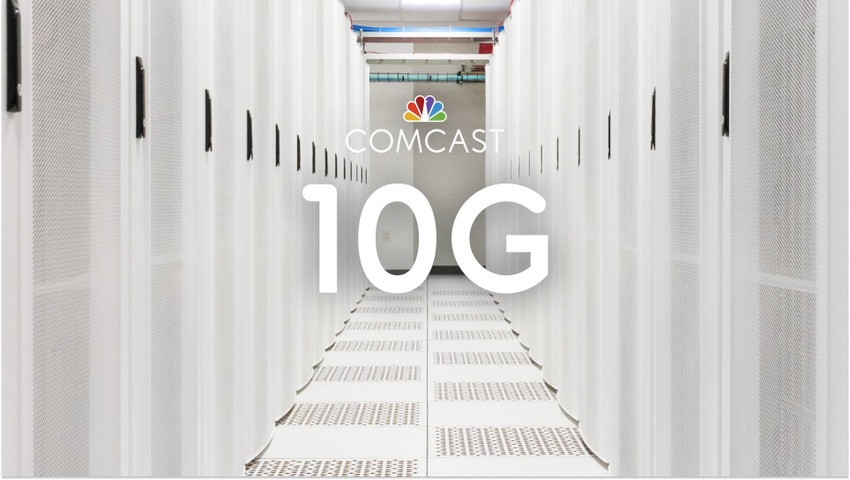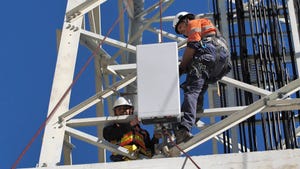Comcast's network upgrade jumps past 120,000 DAA nodes
At Cable-Tec Expo, Comcast's Rob Howald presented an update on the operator's distributed access and virtual CMTS upgrades, and a mega-panel explored what it will take to max out the HFC network.

DENVER – SCTE CABLE-TEC EXPO – In the wake of Comcast's first launch of DOCSIS 4.0 services in Colorado Springs, one of the operator's top network engineering execs offered a glimpse into the progress Comcast is making on its broader distributed access architecture (DAA) upgrade.
Comcast has now deployed more than 120,000 remote PHY nodes into its new distributed architecture and has paired that up with the rollout of more than 1,000 "PPODs," the physical hardware components that run the compute for the operator's virtual cable modem termination system (vCMTS), Rob Howald, VP for network architecture and a fellow at Comcast, said Tuesday during a keynote at a Light Reading-hosted breakfast session.

Comcast's Rob Howald delivers his keynote presentation at a Light Reading-hosted breakfast session on October 17, 2023 at Cable-Tec Expo in Denver. (Source: Jeff Baumgartner/Light Reading)
Comcast is now deploying a third generation vCMTS that enables one rack to serve about 100,000 households passed, up from a generation-two iteration that supported 60,000 homes passed per rack, Elad Nafshi, Comcast's chief network officer, said in a separate presentation on Tuesday. That compares to legacy analog CMTSs that require 20 racks to serve about 60,000 homes passed.
Comcast is achieving greater scale with the vCMTS "just by following Moore's Law," Nafshi said.
Comcast's latest DAA nodes number compares to the 83,000 nodes Nafshi reported about seven months ago, and the 50,000 DAA nodes Howald made note of at last year's Cable-Tec Expo in Philadelphia.
Foundation for widespread rollouts
Comcast's DAA deployment also includes a "mid-split" upgrade that dedicates more spectrum to the upstream and plant largely built to 1GHz, enabling Comcast to offer speeds up to 2 Gbit/s downstream and up to 200 Mbit/s in the upstream on Comcast's widely deployed DOCSIS 3.1 network. Some 3.5 million Comcast customers are currently connected to those speeds.
"There's a lot of work to go but we're at the foundation place" for Comcast's widespread rollout, Howald said.
That overall progress ties into Comcast's network evolution plan to make multi-gigabit downstream speeds and faster upstream speeds available to 50 million homes and businesses before the of 2025.
Increased focus on low latency and network reliability
Howald also talked up how reliability and lower latencies are also key to the industry's "10G" vision. Comcast is in the middle of Low Latency DOCSIS field trials and is building machine language and artificial intelligence technologies into the network to help the operator diagnose and even self-heal network issues. Comcast is also implementing AI tech and telemetry capabilities into new FDX amplifiers that are key to the operator's future D4.0 rollout.
Customers want their broadband to be fast, but uptime is "the number one ask," Howald said.
A follow-up, super-sized breakfast panel focused on "maxing out" the hybrid fiber/coax (HFC) network also played up the growing importance for high reliability.
Applied Optoelectronics (AOI) is among the suppliers working on "smart" amplifier systems that can receive data and pinpoint problems, save operating expenses and improve customer satisfaction, said Todd McCrum, SVP and GM of AOI's broadband access unit.
Charter Communications has similar aims with its upgrade plans, which include a move to DAA and 1.8GHz across a sizable portion of its plant and the ability to see issues as they occur. The new platform is software-driven, adds flexibility and enables field technicians to move faster and be more efficient, said John Williams, Charter's VP of engineering and architecture.
The panel also highlighted how operators are taking varied upgrade paths.
Canada's Rogers Communications is working on mid-split and DAA upgrades that enable the operator to push speeds of 2 Gbit/s down and 200 Mbit/s upstream, giving Rogers a "nice sweet spot" to compete against fiber rivals, said Damian Poltz, SVP of wireline networks at Rogers.
It also gives Rogers a stepping stone to DOCSIS 4.0, when Rogers needs it, he added.
Midco is also using DAA as a path to D4.0. But the operator intends to first "stretch" its existing DOCSIS 3.1 network, Pao Lo, Midco's VP of network engineering, said. Ahead of future D4.0 network upgrades, operating DOCSIS 4.0 modems on a distributed DOCSIS 3.1 network to obtain an interim speed boost "is a compelling story," Lo said.
Midco is also testing a high-split upgrade (enabling a block of upstream capacity of 5MHz-204MHz) with a node+0 architecture (no amps between the node and the premises) for apartments and other multiple dwelling units.
Bumping up the optics
Vecima CTO Colin Howlett predicted that 4.0 won't be the end of the road for DOCSIS. "There's likely one more kick at the can," he said, pointing to the potential for HFC to be built out beyond 1.8GHz.
DOCSIS 4.0 does give operators significant new capacity, but they will also need to do more on the optical transport elements of the network to achieve speeds that flirt with the industry's 10G vision, said Jay Lee, CTO of ATX Networks.
Operators will need a data rate northbound of 10 Gbit/s to provide enough headroom to deliver those kinds of speeds to individual customers, suggested Harj Ghuman, VP of strategic products at Precision Optical Transceivers.
Ghuman said modeling Precision OT has conducted with operators indicates that 25 Gbit/s in the access network could address that need. Precision OT is exploring that with 25G SFP28 transceivers with an built-in dispersion compensation chip that enables transmission out to 40 kilometers.
About the Author(s)
You May Also Like












